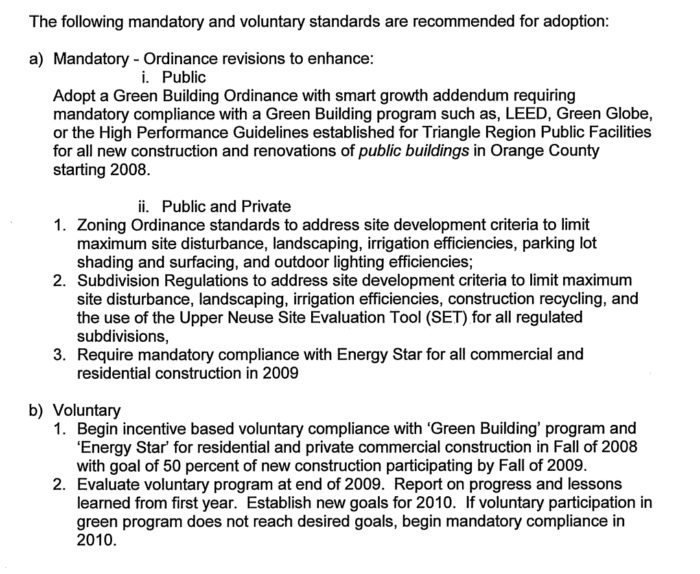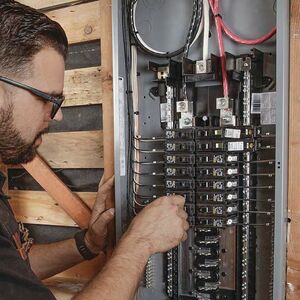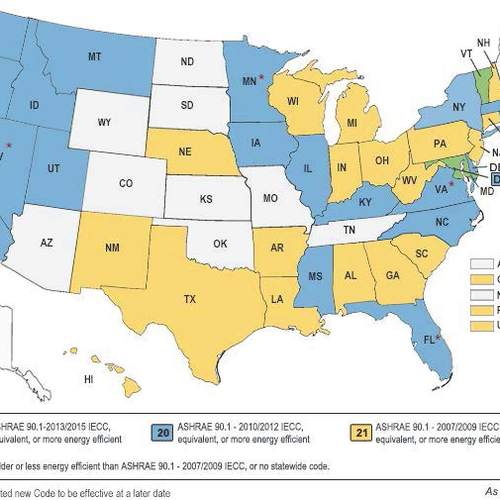A few years ago, I — along with Michele Myers (the “God-Mutha uv Green”) and representatives from county government, planning and inspections staff, architects, remodelers, production builders, commercial builders, utilities, lawyers and business leaders — got together at the behest of our local planning board to work on developing a green building ordinance for our county.
The wrong kind of ordinance could explode in our faces
When we first got to the meeting they seemed ready to mandate 100% Energy Star in 12 months and 100% LEED for Homes in two years. Boom, problem solved…
The first thing to we did was to point out how few builders in our town have actually built an Energy Star home, and we talked about the (well hidden) failure rate for first-time Energy Star builders and the drop-out problem with first time green builders. We have really well-intentioned builders around here who dive into Energy Star and Green Building Programs and fall down hard on the follow-through.
It’s been critical for us as a green building council to have a way of incentivizing follow-through on Energy Star and Green Certification. (We do a lot of education and “green drinks” type networking events, and you can’t have a home on the green building tour if you enter a home in the program and then fail to complete the certification.)
We had to bring it home to the county staff that they weren’t going to just pass a decree and magically have every builder in town come up to the level of training required to meet this standard of workmanship and to meet the level of documentation required to actually pass the certification. We have plenty of builders doing Energy Star quality work and using green building systems, but getting them up to speed on the documentation required for third-party certification is another story.
We also have people who have had land in their family for generations who don’t take kindly to folks who tell them what they can and cannot do with that land — so some salesmanship and diplomacy is required.
Almost two-thirds of the builders in our green building council have yet to certify a home
We have over a hundred builders and many more businesses represented in our council, and we’ve certified well over 500 homes to our evolving green building standard, but those homes represent just forty builders. The rest are taking the classes and incorporating green building systems into the homes they build but have yet to make the step to actually certify any of the homes they build.
If the county made it mandatory, we’d probably see them rush to get on the bus. But we’d also see a heavy failure rate and the county was going to need to have a good plan for what the consequences would be if a builder made a good try to be green and Energy Star certified and came up short. We argued for the use of rewards rather than requirements, and the county staff argued back that until it was mandatory there would be no compliance. In fact, there are many items in the existing building code that are mandatory and are not being enforced. (Accurate and meaningful Manual J calculations top that list.)
So we worked out a staged implementation
I was really impressed by the amount of homework that the county staff and inspectors had done. They had assembled and studied a huge binder of green building programs from many cities and counties all over America.
I was also impressed with the extent that the building inspectors and planning staff were aware of the struggles of the business community. I also noticed that they were overwhelmed by demands put on them by the county commissioners to continually do more work without expanding their budget. At the same time their initial approach seemed alarmingly simplistic and poorly considered.
Nothing simple about defining what is green
In addition to LEED for Homes, we have a very strong Earth Craft program here in the Southeast. We also have our solar-focused NC Healthy Built program and a strong program based on the NAHB Green Building Initiative. We have a small pocket of the Audubon Green Leaf program and we also have some odd little “self-certifying” going on (i.e., greenwashing) — plus we have a whole cadre of old-school solar builders and natural builders who are so far to the left of the political spectrum that they refuse to concede that certification is relevant to what they’re doing.
Between us we find very little consensus on what is the minimum definition of a green home.
Incentives proved to be harder than anticipated
Expedited permitting for plans that were enrolled in Energy Star and a green certification program was an easy give for the inspections and zoning departments, but we have a health department (managing the well and septic applications in the county) that just didn’t come to the table.
You can expedite zoning and plans review all you want, but if the septic and well permits still take a month you’re just hurrying up to wait. Permit fee give-backs were considered but the county budget is already a sea of red ink and our permit fees are pretty reasonable already.
All plans accepted
The inspectors were very apprehensive about needing to become versed in green building best practices, so they were easily convinced to allow any “generally recognized third party green certification program” to be recognized. By giving builders and architects the freedom to select, and pay for, third-party certification, the county hasn’t had to adopt any one standard over the others, and they don’t have to train all the inspectors to be Green certifiers or Energy Star certifiers.
The county does have a great information tech staff, so they offered to create and host a Web site that would list all the builders who had certified a project to Energy Star or third-party green certification on the county Web site. No ads, just a list of which builders had certified homes and how many and how recent and what level of energy or green verification they had received. This online list helps to separate the greenwashers from the good builders, it encourages verification, and it was produced at very little cost to the county.
A combined effort on green jobs training
Our local HBA offered to give scholarships for our green building classes to building inspectors, high school teachers, and community college teachers. These scholarships were offered through our HBA educational foundation which has been set up to encourage high school students to go into the trades.
That has worked out well, but I have to admit that it’s pretty intimidating to teach those guys. The county also agreed to apply for grants to promote green building education on their own and to support a green building home tour. (We have two tours per year, one in the fall that focuses more on solar builders and one in the spring that focuses more on “mainstream green.”)
No “county endorsements” of one builder over another — just the facts
We also discussed creating “Orange County Goes Green” job site signs and a “wall of green” in the permit office that would display the green builder info they agreed to put on the Web site. That idea has gone nowhere as yet; I think it’s been killed by their legal department since it looks too much like a county endorsement.
We’ve also been kicking the PACE program back and forth for a while; it may yet get some traction.
Still, mandates are inevitable
Of course the introduction of the carrot is just an attempt to postpone the stick. If we don’t hit 50% Green and Energy Star participation by the fall of 2010, they intend to go back to setting mandates.
The new building code is a mandate, and — despite all the gnashing of teeth that is going on — it’s a giant step in the right direction. So, for that matter, is the proposed Energy Star revision. (Step away from the blogosphere and read the freakin’ documents. If you’re a conscientious builder, you will not have any problem with what they say.)
So this is why I have global warming skeptics in my green building classes
The writing is on the wall. We will not hit 50% participation this year by a long shot, so we will be meeting in the summer and fall to discuss phasing in the mandates — which means that the builders who haven’t learned how to build green will have a longer drive to compete for fewer jobs outside of the county and building costs around here will go up once again — at the same time that impact fees are going up and wages are stagnant and declining.
Learning how to build and remodel affordable and green is looking like a better business strategy every day.
Weekly Newsletter
Get building science and energy efficiency advice, plus special offers, in your inbox.















3 Comments
List of builders w/ certified homes
I like the idea of having a website where I could see which builders were building to which third-party certifications programs. I'd love to have that information available in my community.
"...a Web site that would list all the builders who had certified a project to Energy Star or third-party green certification on the county Web site. No ads, just a list of which builders had certified homes and how many and how recent and what level of energy or green verification they had received. This online list helps to separate the greenwashers from the good builders, it encourages verification, and it was produced at very little cost to the county."
Shades of green
I really think such an effort will require a building performance certificate to command any real attention. The average citizen is tired of the overuse of green and needs a way to separate the energy conscious builders from the "newly green" that lack any real portfolio of energy efficient buildings. You can't fake it, you must have experience to convince the buying public, I don't know about others but I am very busy these days, my 27 years of building super efficient buildings is yielding fruit.
Efficiency, green, and the 2009 IECC
It sounds like you're making great progress in your area, Michael. This is a trend that's not going away, I believe, and the 2009 IECC will help building departments and builders move along this path whether they want to or not. Any state that accepted ARRA money is bound to adopt that code and reach 90% compliance. The big new requirement in it is that if the ducts are not inside the conditioned space, they have to be tested for leakage. I'd also love to see the 90% compliance force builders' hands on the Manual J issue. That's been in the code for a while, yet most building departments couldn't care less about it.
Allison A. Bailes III, PhD
energyvanguard.com
Log in or create an account to post a comment.
Sign up Log in